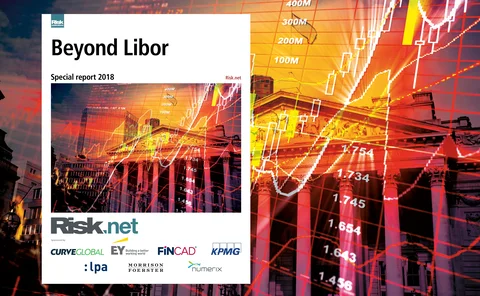Sponsored content
For further information on creating and publishing sponsored content, please click here.
Embracing the sea change to come with FRTB
Firms have until 2021 to implement FRTB, and those yet to begin compliance efforts risk putting themselves at a disadvantage. EY‘s financial services risk partners Shaun Abueita and Sonja Koerner explore the current level of readiness within the industry…
Hong Kong ETFs spotlighted amid growing A-share interest
Hong Kong’s exchange-traded fund market takes centre stage in international investors’ foray into Chinese markets, experts say. By Hong Kong Exchanges and Clearing (HKEX)
Beyond Libor special report 2018
Financial markets are sitting on a time bomb. In just over three years’ time, the rate that underpins $350 trillion of financial contracts could disappear. Whether by choice or by regulatory force, transition away from discredited Libor rates is…
Asia embraces intelligent automation
Asia’s adoption of new tools and processes has gained significant momentum, with increased automation now a primary focus for many financial firms. Paul Worthy, head of Japan at Tradeweb, explores how this change has come about, and how firms can use the…
Institutional ETF trading: Liquidity improving, trade sizes growing
Sponsored survey report: Jane Street
Ripple effect: The impact of moving away from Libor
Sponsored Q&A
IFRS 9 versus IAS 39: Opportunities in changes to hedge accounting
With financial reporting in a state of flux amid the introduction of several new accounting standards, many corporates may feel overburdened by the need to ensure accounting compliance to take full advantage of IFRS 9 from the point of adoption. Robert…
Transitioning beyond Libor: Some key considerations
Liang Wu, vice-president of financial engineering and head of CrossAsset product management at Numerix, explores the transition to Libor alternative rates and the impact on curve construction practices
Is Libor going away?
Amid widespread expectation that Libor will soon be discontinued, questions are being asked around whether the transitioning towards risk-free rates will prove too onerous to achieve. Christopher Dias, principal, advisory, at KPMG, explores whether the…
Ibor transition valuation and risk management considerations
The impending move from interbank offered rates to alternate reference rates will require important changes to many valuation and risk management processes and infrastructure. EY Financial Services’ Shankar Mukherjee, Michael Sheptin and John Boyle…
RFR valuation challenges
A new system of interest rate benchmarks for all major currencies is emerging. These new benchmarks will replace interbank funding rates with risk-free rates (RFR). This article by LPA focuses on valuation challenges during the transitional period to new…
A call to arms – How machine intelligence can help banks beat financial crime
The revolution in artificial intelligence promises new leads in banks’ fight against dirty money. Alexander Campbell of Risk.net hosted a live online forum, in association with NICE Actimize, to investigate the applications of this emergent technology
Pensions and insurers give new impetus to Asia’s ETFs
Cost-conscious institutional investors are embracing exchange-traded funds (ETFs) to lower transaction fees and achieve higher returns. Hong Kong Exchanges and Clearing (HKEX) explores the theme of yield‑chasing among insurers in Asia’s expanding ETF…
Preparing for the initial margin phase-in
Requirements for the mandatory exchange of initial margin are expected to be time‑consuming and laborious to implement. David White, head of sales at triResolve, discusses the lessons learned from in‑scope firms, obstacles to achieving compliance and how…
Defining the next generation of GRC
Firms are now under pressure to significantly transform governance, risk and compliance processes. Traditional mechanisms of effective risk management and regulatory compliance are fast becoming outdated. New technologies such as machine learning and…
Delving into the FASB's current expected credit loss model
The Financial Accounting Standards Board's current expected credit loss rule could mean loss provisions for loans are three times higher than with International Financial Reporting Standard 9























